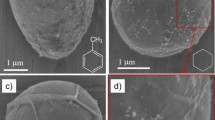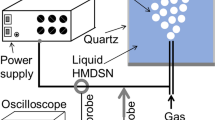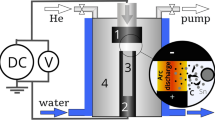Abstract
We studied composite wires assembled from electric field-driven nanoparticles in a dielectric liquid (heptane) to elucidate the exact processes and controlling factors involved in the synthesis of the multi-phase nanocomposites. Filamentary wires are synthesized by a two-step process: (1) abundant nanoparticle production, mostly of carbonaceous types, from heptane decomposition by spark discharge and of metal nanoparticles by electrode erosion and (2) assembly of hydrogenated amorphous carbonaceous nano-clusters with incorporated metal nanoparticles forming wires by dielectrophoretic transport while maintaining a high electric field between electrodes kept sufficiently separated to avoid breakdown. Four types of nanocomposites products are identified to form at different steps in distinctive zones of the setup. The black carbonaceous agglomerates with metal spherules made by electrode erosion represent the pyrolytic residues of heptane decomposition by spark discharge during step 1. The filamentary wires grown in the interelectrode gap during step 2 get assembled by dielectrophoretic transport and chaining forces. Their great stability is shown to express the concurrent effect of polymerization favoured by the abundance of metal catalysts. The nature, abundance, and transformation of solid particles from the source materials versus discharge conditions control the morphological and compositional diversity of the wires. The production of mineral and metal nano-particles traces the efficiency of dielectrophoresis to separate compound particle mixtures by size and to co-synthesize nanostructured microcrystals and nanocomposites. The link between impurities and the variability from nano- to micro-scales of the synthesized products provides an innovative contribution to the knowledge of nanocomposite synthesis triggered by electric field.














Similar content being viewed by others
References
Graham WG, Stalder KR (2011) Plasmas in liquids and some of their applications in nanoscience. J Phys D Appl Phys 44:174037
Ashkarran AA (2011) Metal and metal oxide nanostructures prepared by electrical arc discharge method in liquids. J Clust Sci 22:233–266
Belmonte T, Hamdan A, Kosior F, Noël C, Henrion G (2014) Interaction of discharges with electrode surfaces in dielectric liquids: application to nanoparticle synthesis. J Phys D Appl Phys 47:224016
Burakov VS, Nevar EA, Nedel’ko MI, Tarasenko NV (2015) Synthesis and modification of molecular nanoparticles in electrical discharge plasma in liquids. Russ J Gen Chem 85:1222–1237
Saito G, Akiyama T (2015) Nanomaterial synthesis using plasma generation in liquid. J Nanomater 2015:123696
Hamdan A, Noël C, Belmonte T (2014) Synthesis of carbon fibres by electrical discharges in heptane. Mater Lett 135:115–118
Liu S-M, Kobayashi M, Sato S, Kimura K (2005) Synthesis of silicon nanowires and nanoparticles by arc-discharge in water. Chem Commun 37:4690–4692
Sano N, Tamon H (2014) Submerged arc discharge technique to explore novel non-carbon nanotubes: syntheses of nanotubes from ZnO and BaTiO3. Jpn J Appl Phys 53:048002
Sagara T, Kurumi S, Suzuki K (2014) Growth of linear Ni-filled carbon nanotubes by local arc discharge in liquid ethanol. Appl Surf Sci 292:39–43
Yao WT, Yu SH, Zhou Y, Jiang J, Wu QS, Zhang L, Jiang J (2005) Formation of uniform CuO nanorods by spontaneous aggregation: selective synthesis of CuO, Cu2O, and Cu nanoparticles by a solid–liquid phase arc discharge process. J Phys Chem B 109:14011–14016
Krishnan S, Haseeb ASMA, Johan MR (2013) Synthesis and growth kinetics of spindly CuO nanocrystals via pulsed wire explosion in liquid medium. J Nanopart Res 15:1410
Xie SY, Ma ZJ, Wang CF, Lin SC, Jiang ZY, Huang RB, Zheng LS (2004) Preparation and self-assembly of copper nanoparticles via discharge of copper rod electrodes in a surfactant solution: a combination of physical and chemical processes. J Solid State Chem 177:3743–3747
Hermanson KD, Lumsdon SO, Williams JP, Kaler EW, Velev OD (2001) Dielectrophoretic assembly of electrically functional microwires from nanoparticle suspensions. Science 294:1082–1086
Velev OD, Gangwal S, Petsev DN (2009) Particle-localized AC and DC manipulation and electrokinetics. Ann Rep C Phys Chem 105:213–246
Lumsdon SO, Kaler EW, Velev OD (2004) Two-dimensional crystallization of microspheres by a coplanar AC electric field. Langmuir 20:2108–2116
Decher G, Eckle M, Schmitt J, Struth B (1998) Layer-by-layer assembled multicomposite films. Curr Opin Colloid Interface Sci 3:32–39
Cassagneau TP, Sweryda-Krawiec B, Fendler JH (2000) Rectifying self-assembled ultrathin films. MRS Bull 25:40–46
Hamdan A, Noël C, Ghanbaja J, Migot-Choux S, Belmonte T (2013) Synthesis of platinum embedded in amorphous carbon by micro-gap discharge in heptane. Mater Chem Phys 142:199–206
Durand B, Monin JC (1980) Kerogen: insoluble organic matter from sedimentary rocks. In: Durand B (ed) Chap. 4: elemental analysis of kerogens (C, H, O, N, S, Fe), TECHNIP, Paris
Witten TA, Sander LM (1983) Diffusion-limited aggregation. Phys Rev B 27:5686–5697
Ludvigsson L, Meuller BO, Messing ME (2015) Investigations of initial particle stages during spark discharge. J Phys D Appl Phys 48:314012
Molinder R, Sandström L, Wiinikka H (2016) Characteristics of particles in pyrolysis oil. Energy Fuels 30(11):9456–9462
Author information
Authors and Affiliations
Corresponding author
Rights and permissions
About this article
Cite this article
Hamdan, A., Kabbara, H., Courty, MA. et al. Synthesis of Carbon–Metal Multi-Strand Nanocomposites by Discharges in Heptane Between Two Metallic Electrodes. Plasma Chem Plasma Process 37, 1069–1090 (2017). https://doi.org/10.1007/s11090-017-9816-8
Received:
Accepted:
Published:
Issue Date:
DOI: https://doi.org/10.1007/s11090-017-9816-8




